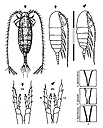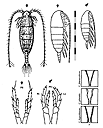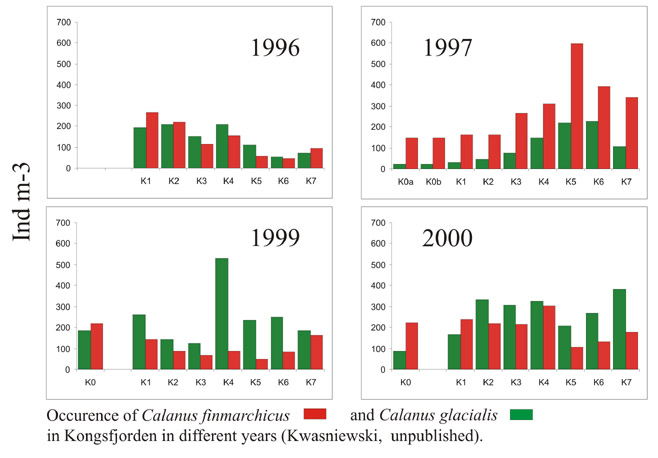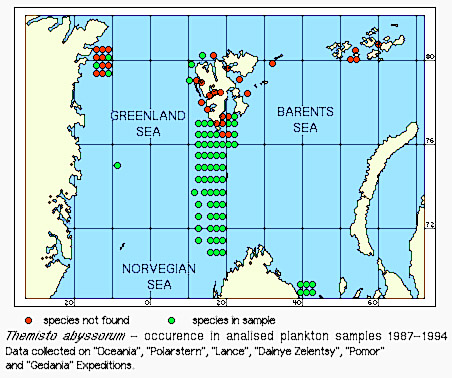7. IDENTIFICATION SHEETS FOR KEYSTONE SPECIES OF KONGSFJORDEN & HORNSUND
Plankton - Crustacea
![]()
|
|
genus Calanus, family Calanidae, order Calanoida
Calanus finmarchicus, (Jashnov, 1955) C. hyperboreus, (Kroyer, 1838) |



(3x 1000x1250) |
|
Three, relatively large, sibling species of herbivorous mesozooplankton, indicative for different water masses. C. finmarchicus for boreal, Atlantic waters, C.glacialis for Arctic shelf waters and C. hyperboreus for Arctic deep ocean waters. The three species occur in fjords in different proportions in different years, depending on variable hydrological situation. Density may reach 1000 individuals in m3. Example of distribution within the fjords shows the diagram. 
How to recognize the species practically? Measure the prosome length (in mm) for each development stage and compare it with table, these are best, efficient diagnoses:
See also the photo in species gallery menu 6.6.4. |
|
genus Themisto, family Hyperiidae, order Amphipoda
Themisto libellula, (Lichtenstein, 1822) T. abyssorum, (Boeck, 1871) |

(273x285) |
 Two large (10-40 mm) macroplanktonic, carnivorous crustaceans, common and abundant allover the area, T. abyssorum is of more boreal-southern distribution, while T. libellula is more cold water, often ice associated pelagic species. T. libellula have a life span of 2-3 years, while T. abyssorum 1-2 years. The density may reach 10 ind/m3, both species make very important component of local seabirds, sea mammals and fishes diet. For regional distribution see the map.
Two large (10-40 mm) macroplanktonic, carnivorous crustaceans, common and abundant allover the area, T. abyssorum is of more boreal-southern distribution, while T. libellula is more cold water, often ice associated pelagic species. T. libellula have a life span of 2-3 years, while T. abyssorum 1-2 years. The density may reach 10 ind/m3, both species make very important component of local seabirds, sea mammals and fishes diet. For regional distribution see the map.
How to recognize the species ? Look at the last joint of pereiopods; T. libellula has short 7th joint (claw) with distinct small seate at the inner edge T. abyssorum has long, sable like 7th joint, with smooth inner edge See also the photo in species gallery menu 6.6.4. |
|
genus Thysanoessa, family Euphausidae, order Euphausiacea
Thysanoessa inermis, (Lichtenstein, 1822) T. abyssorum, (Kroyer, 1846) |
|
|
Large, 20-30 mm long macroplanktonic epipelagic, herbivorous crustacean. In Svalbard fjords at the edge of its geographical distribution, does not breed there. In some places attain densities up to 10 ind/m3. Important component of seabirds and sea mammals food.
How to recognize the species? It differs from three other species of the same genus by the smooth carapax without spines and presence of distinct spine at the upper edge of last pleon segment. See also the photo in species gallery menu 6.6.4. |
